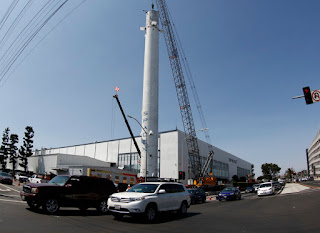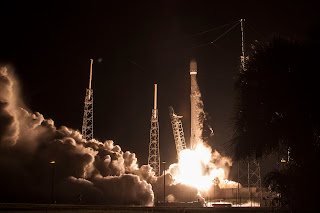 |
| CRS-8 Booster on the Droneship |
 |
| Launch of CRS-8 |
 |
| SES-9 on top of a Falcon 9 |
 |
| CRS-8 Booster on the Droneship |
 |
| Launch of CRS-8 |
 |
| SES-9 on top of a Falcon 9 |
 |
| Credit: Gene Blevins/LA Daily News |
 NASA's OSIRIS-Rex was viewed by the media for the last time before encapsulation yesterday on August 20th. Members of the media entered the cleanroom where the Spacecraft sat on display with the Atlas V 4 meter fairing sitting nearby. The launch is set for September 8th aboard an Atlas V in its 411 configuration with one strap-on Solid Rocket Booster. During the media event, principal investigator Dante Laurette who has been working on the project for 12 years, helped to fill us in with the mission guidelines and goals. "Once the OSIRIS-Rex spacecraft gets to Bennu, we'll basically be flying in formation with the asteroid.". The spacecraft will use the combination of four reaction wheels for orientation and sixteen small thrusters across it to keep its science instruments pointed at the asteroid. There are also star trackers on the spacecraft to help guide it through space using the stars. This is also the first spacecraft to launch with the sixteen low-thrust engines. Another feature of OSIRIS-Rex is the solar panels are on gimbals and have sensors to track the sun and keep the panels pointed at it. "We'll go from flybys into orbit and in orbit we and do characterization from points of interest," said Dante while explaining the timeline of the mission at the asteroid. For this mission, the required sample from the asteroid is 60g (2oz) of material. The spacecraft will do several low-altitude flybys of the asteroid until it's point of interest is chosen and is set to retrieve a sample. The arm on the spacecraft will extend and grab the required sample in 5 seconds of contact,
NASA's OSIRIS-Rex was viewed by the media for the last time before encapsulation yesterday on August 20th. Members of the media entered the cleanroom where the Spacecraft sat on display with the Atlas V 4 meter fairing sitting nearby. The launch is set for September 8th aboard an Atlas V in its 411 configuration with one strap-on Solid Rocket Booster. During the media event, principal investigator Dante Laurette who has been working on the project for 12 years, helped to fill us in with the mission guidelines and goals. "Once the OSIRIS-Rex spacecraft gets to Bennu, we'll basically be flying in formation with the asteroid.". The spacecraft will use the combination of four reaction wheels for orientation and sixteen small thrusters across it to keep its science instruments pointed at the asteroid. There are also star trackers on the spacecraft to help guide it through space using the stars. This is also the first spacecraft to launch with the sixteen low-thrust engines. Another feature of OSIRIS-Rex is the solar panels are on gimbals and have sensors to track the sun and keep the panels pointed at it. "We'll go from flybys into orbit and in orbit we and do characterization from points of interest," said Dante while explaining the timeline of the mission at the asteroid. For this mission, the required sample from the asteroid is 60g (2oz) of material. The spacecraft will do several low-altitude flybys of the asteroid until it's point of interest is chosen and is set to retrieve a sample. The arm on the spacecraft will extend and grab the required sample in 5 seconds of contact,  |
| RS-25 engine test Credit: NASA |
 Last night at 12:52am EDT, the Delta IV Medium+ (4,2) rocket roared to life as it ignited it's RS-68 engine and 2 solid rocket boosters and flew off the pad. The rocket produced 1.1 Million pounds of thrust to push itself and 2 twin satellites into space. The twin satellites are for surveillance purposes launched into a Geosynchronous Orbit around the Earth. This orbit is so the satellites stay above the same part of Earth as it orbits. After fairing separation the live broadcast ended as requested by the customer. Seven hours later, a press release confirmed the two satellites made it successfully into their proper orbits leading to another successful launch by ULA.
Last night at 12:52am EDT, the Delta IV Medium+ (4,2) rocket roared to life as it ignited it's RS-68 engine and 2 solid rocket boosters and flew off the pad. The rocket produced 1.1 Million pounds of thrust to push itself and 2 twin satellites into space. The twin satellites are for surveillance purposes launched into a Geosynchronous Orbit around the Earth. This orbit is so the satellites stay above the same part of Earth as it orbits. After fairing separation the live broadcast ended as requested by the customer. Seven hours later, a press release confirmed the two satellites made it successfully into their proper orbits leading to another successful launch by ULA.
 |
| JCSAT-16 first stage returning from Sea Credit Mary Ellen Jelen / We Report Space |
 |
| Closeup of slight damage from Reentry Credit Mary Ellen Jelen / We Report Space |
 |
| IDA-2 being loaded into Dragon's Trunk |
 For the first time since the Space Shuttle era, there is a Crew access arm and Whiteroom at the Cape Canaveral Air Force Station. Today, August 15th, the CST-100 Starliner spacecraft's Crew Access Arm was installed at ULA's launch pad for when their Atlas V launches crew to the ISS for the first time around 2017. Construction of the crew access arm began about 7 months ago, "This is another step in a long process we began back in February 2015 to construct our crew access tower.". It will take a few months to hook up and install everything on the tower and to test it. The lead of Boeing's Commercial Crew Launch Site, Lisa Locks said, "This is
For the first time since the Space Shuttle era, there is a Crew access arm and Whiteroom at the Cape Canaveral Air Force Station. Today, August 15th, the CST-100 Starliner spacecraft's Crew Access Arm was installed at ULA's launch pad for when their Atlas V launches crew to the ISS for the first time around 2017. Construction of the crew access arm began about 7 months ago, "This is another step in a long process we began back in February 2015 to construct our crew access tower.". It will take a few months to hook up and install everything on the tower and to test it. The lead of Boeing's Commercial Crew Launch Site, Lisa Locks said, "This is
 |
| Launch of JCSAT-16 Photo Cred: SpaceX |
 |
| JCSAT-16 first stage on Droneship after landing Photo Cred: SpaceX |
 The SpaceX team is prepping for the launch of JCSAT-16 from Cape Canaveral, Florida at 1:26am EDT on Sunday. You can watch the launch live at http://www.spacex.com/webcast. The press kit can be found here.
The SpaceX team is prepping for the launch of JCSAT-16 from Cape Canaveral, Florida at 1:26am EDT on Sunday. You can watch the launch live at http://www.spacex.com/webcast. The press kit can be found here.
"Of Course I Still Love You" positioned in the Atlantic Photo // SpaceX To this date, SpaceX currently has 2 droneships to lan...
